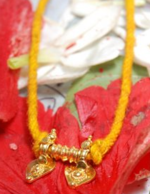| Revision as of 20:09, 9 December 2021 editHariombhargav (talk | contribs)28 edits referenceTag: Manual revert← Previous edit | Revision as of 10:48, 15 July 2022 edit undo210.212.239.233 (talk)No edit summaryNext edit → | ||
| Line 1: | Line 1: | ||
| ] | ] | ||
| '''Pushpaka Brahmin''' is a generic term that refer to a group of various ] ] castes of ] in the ] community.<ref>{{cite book|url=https://books.google.com/books?id=JmjaAAAAMAAJ&q=puspakar |title=Polity, Society, and Women: With Special Reference to Travancore, 1700-1900 A.D. |first=Suma |last=Rose |publisher=Carmel International Publishing House |year=2004 |page=217 |isbn=9788187655374 |accessdate=2013-04-30}}</ref> Pushpaka Brahmin include primarily two castes - ] (or Pushpaka Unnis) and ], who were assigned the job of tending flowers and making garlands in the Hindu temples and were given rights to teach sacred texts and Sanskrit language in the Pathasalas associated with Hindu temples. Later some other communities like Theeyatt Unnis, Kurukkals, and |
'''Pushpaka Brahmin''' is a generic term that refer to a group of various ] ] castes of ] in the ] community.<ref>{{cite book|url=https://books.google.com/books?id=JmjaAAAAMAAJ&q=puspakar |title=Polity, Society, and Women: With Special Reference to Travancore, 1700-1900 A.D. |first=Suma |last=Rose |publisher=Carmel International Publishing House |year=2004 |page=217 |isbn=9788187655374 |accessdate=2013-04-30}}</ref> Pushpaka Brahmin include primarily two castes - ] (or Pushpaka Unnis) and ], who were assigned the job of tending flowers and making garlands in the Hindu temples and were given rights to teach sacred texts and Sanskrit language in the Pathasalas associated with Hindu temples. Later some other communities like Theeyatt Unnis, Kurukkals, Puppallis, Pilappallis, Nambidis and Daivampadis having similar culture and temple-related jobs were also considered to be Pushpaka Brahmins.<ref>{{cite book |title=Report of the Commission for Reservation of Seats in Educational Institutions, Kerala, 1965 |date=1965 |publisher=Commission for Reservation of Seats in Educational Institutions |location=Kerala}}</ref> | ||
| ==Community welfare== | ==Community welfare== | ||
Revision as of 10:48, 15 July 2022

Pushpaka Brahmin is a generic term that refer to a group of various Hindu Brahmin castes of Kerala in the Ambalavasi community. Pushpaka Brahmin include primarily two castes - Pushpakas (or Pushpaka Unnis) and Nambeesans, who were assigned the job of tending flowers and making garlands in the Hindu temples and were given rights to teach sacred texts and Sanskrit language in the Pathasalas associated with Hindu temples. Later some other communities like Theeyatt Unnis, Kurukkals, Puppallis, Pilappallis, Nambidis and Daivampadis having similar culture and temple-related jobs were also considered to be Pushpaka Brahmins.
Community welfare
Nowadays, Pushpaka Brahmins are reluctant to cling to their traditional professions like priesthood, adhyapanam (teaching) in Pathasalas, malakettu (garland making), vilakkeduppu (lamp bearing). Due to low income from these professions. Sree Pushpakabrahmana Seva Sangham is an organisation working for the welfare of Pushpaka Brahmin castes.
References
- Rose, Suma (2004). Polity, Society, and Women: With Special Reference to Travancore, 1700-1900 A.D. Carmel International Publishing House. p. 217. ISBN 9788187655374. Retrieved 2013-04-30.
- Report of the Commission for Reservation of Seats in Educational Institutions, Kerala, 1965. Kerala: Commission for Reservation of Seats in Educational Institutions. 1965.
- "62 Priests to Travancore Devaswam Board" (in Malayalam). Malayala Manorama. Quote:തിരുവിതാംകൂർ ദേവസ്വം ബോർഡ് ക്ഷേത്രങ്ങളിലേക്ക് 62 ശാന്തിക്കാർ കൂടി - നായർ, വാരിയർ, മാരാർ, പുഷ്പകർ എന്നീ വിഭാഗങ്ങളിൽനിന്ന് ആരുമില്ല.